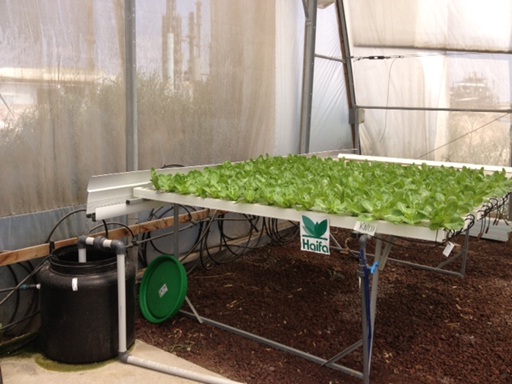An NFT (Nutrient Film Technique) system was recently installed in Haifa's greenhouse, allowing us to address fertilization issues with improved precision and speed. But first, let me explain a bit about the NFT system.
So what is NFT?
 NFT is a hydroponic system, designed for optimal and accelerated plant growth in soilless medium. In a properly installed NFT system, the plant is located in a recirculating, shallow stream of water, which allows supply of oxygen, while supplying dissolved nutrients required for plant growth.
NFT is a hydroponic system, designed for optimal and accelerated plant growth in soilless medium. In a properly installed NFT system, the plant is located in a recirculating, shallow stream of water, which allows supply of oxygen, while supplying dissolved nutrients required for plant growth.
Unlike soil medium, the plant's roots in the NFT system are subjected to constant supply of water and nutrients, and are not forced to develop a massive root zone. This allows the plant to focus on producing quality leaves and fruits. NFT system is suitable for small leafy crops such as basil or lettuce, or larger fruit crops such as cucumbers, tomatoes and even strawberry (see photos below).
How does NFT work?
For best understanding of how the NFT system works, let's follow the water's path. In our case it begins with a tank full of desalinated water, to avoid salt accumulation during recirculation. Nutrients are added by using water soluble fertilizers, so the solution in the tank becomes the final feed solution. Then, a submersible pump drives the feed solution through the main pipeline later to enter the growth channels via thin pipes, creating a shallow stream “washing” the plant's roots. Thus, the roots receive the required water and nutrients, and the solution keeps flowing through the channel until it reaches the gutter that drains all the water back to the water tank, which in turn recirculates the water back to the system (see photos).
 In view of recirculation, there is a constant need to compensate for the plant's uptake of water and nutrients. For that cause, the water tanks are connected by pipes to larger final solution tanks, containing desalinated water and nutrients, ready to pump-in fresh supply for the plants.
In view of recirculation, there is a constant need to compensate for the plant's uptake of water and nutrients. For that cause, the water tanks are connected by pipes to larger final solution tanks, containing desalinated water and nutrients, ready to pump-in fresh supply for the plants.
In a well-designed NFT system, essential parameters of the growing solution such as pH, Electric conductivity (EC) or nitrogen level are automatically and constantly monitored. When a certain parameter is deviating from the required values, the computer controls the valves to adjust various related parameters or let in a new final solution until the parameter is back to its required value. This advanced technique of nutrition control helps the NFT growers to enhance their crop yield and profits.
NFT system and plant nutrition
In order to achieve optimal plant nutrition using the NFT system, it's crucial to use the appropriate fertilizers having a low sodium content, being fully water soluble to use desalinated water and to supply the plant with satisfactory levels of all macro elements - N in the right nitrate to ammonium ratio, P and K, secondary elements (Ca, Mg and S) and trace elements.
Plant requirements may vary between plant species, cultivars, water quality, climate and market demands, therefore there is a constant need for exploring and establishing a wide database. In general, PH levels should range from 5.5 to 6.5 which is the ideal range for ideal nutrient uptake. Ideal E.C ranges between 1.5-2.5 to prevent salt stress or shortages.
Haifa's NFT system
We adopted the NFT system in Haifa's greenhouse, so we could learn more thoroughly about various fertilization issues: the plant's precise nutritional requirements through the growth season, efficiency of a new fertilizer or competition between different sources of an element and so on.
For example, a test recently performed in Haifa's greenhouse, showed that Multi-K fertilizer (potassium nitrate) serves as a better source of potassium than potassium chloride. The use of potassium nitrate enlarged basil yield by 10% (see photos).
In conclusion, The NFT system will help Haifa's agronomists to develop and share new knowledge in order to improve farmer's yields and profits.
Related articles:
Nutrient deficiency | NPK | Plant Nutrition & Plant Fertilizer | Foliar Spray | Calcium Nitrate Fertilizer | Foliar Fertilizer

